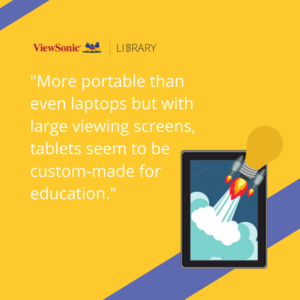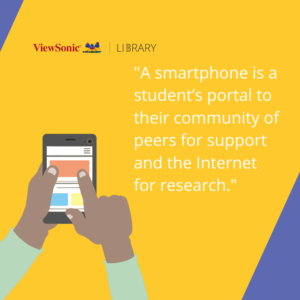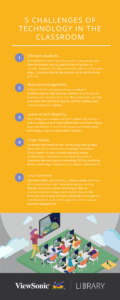There has always been technology in the classroom, even if it hasn’t always been welcome. Take a brief look at the history of technology’s uneasy relationship with education. Then see some common modern additions to the classroom ranging from computers to smartphones. Then you won’t want to miss the advantages (and disadvantages) to modern EdTech. However, the advantages far outweigh the disadvantages, so we also provide a simplified implementation guide.
Continue reading to learn everything you always wanted to know about technology in the classroom.
There has always been technology in the classroom. From books to tablets or slates to interactive whiteboards, humans have used learning tools for as long as we have had formal education.
And while the technology itself changes, some things remain the same. Teachers teach, learners learn, and everyone is uncertain about the latest tech’s role in education. Luckily, we have put together this guide for you to see a more complete picture of how technology fits into the 21st-century classroom.
A Brief History of Technology in the Classroom
Technology has always had an uneasy relationship with education.
There was a time when the only available method of storing information was in people’s memories. Learners would memorize what their elders said. Scholars would have long dialogs, which learners would also have to memorize. Information was passed down through oral traditions of songs, stories, or memorized lectures. This was education without any technology.
Then books showed up on the scene. Books allowed people to store knowledge externally without having to remember every fact. They were a permanent record of known information that could be passed down intact. It was a breakthrough in the storage and transmission of information, so naturally, people hated it.
Socrates famously criticized books (and writing in general) as a weakness saying to Plato, “This discovery of yours will create forgetfulness in the learners’ souls because they will not use their memories.” Of course, we know this because Plato wrote it down.
And so began a long history of the old guard resisting the latest technology in education. Each time new technology is introduced to schools and students, it’s the same story. Those educators who are set in their ways resist. Then they are overtaken by the younger generation trying out new things, finding the ones that work, and then implementing their new methods until something newer comes along. Rinse and repeat throughout the history of education.
- late 1700s – The slate provides students with a portable, personal writing surface.
- 1890s – The chalkboard appeared in classrooms, allowing larger class sizes.
- 1900s – Mass-produced pencils and paper allowed students to have permanent written records of their work.
- 1920s – Radio’s popularity leads to on-air classes.
- 1930s – Overhead projectors adopted.
- 1951 – Videotapes allow for audio and visual content.
- 1959 – Photocopiers allowed schools to mass-produce printed materials on site.
- 1980s – Personal computers are available to the average consumer.
- 1990 – The Internet brings about unprecedented access to information.
- 1991 – Interactive whiteboards become available.
- 2005 – Learning Management System (LMS) takes off as a viable teaching tool.
- 2012 – The iPad brings tablets into public perception.
Click here for a more complete timeline on the history of EdTech.
Types of Technology in the Classroom
While interesting, the history of EdTech probably doesn’t help your students very much in the here and now. What technology is available in the modern classroom? And what is it doing for education?
Computers
Both desktops and laptops continue to have places in modern classrooms. At many schools, laptops are issued to students to use throughout the school year. In general lessons, laptops are used primarily for note-taking, writing, and independent research. Depending on the material being presented, computers also present an opportunity for adding more media to lessons, gamification, and connectivity with either classmates or instructors.

More powerful desktops are usually saved for computer-specific courses and computer labs, but they also have their place in the classroom. (A desktop is often part of a resource center for younger grades where it’s not yet appropriate for each student to have their own laptop.)
But while computers have value in the classroom, it’s important to note that they have limitations. For example, research suggests that taking notes by hand may be more effective than typing (though this is not yet definitive). And then there’s the potential for distraction in Internet-enabled laptops, but this could probably be said about windows on sunny days as well.
The bottom line is that computers are commonly found in classrooms, and they are likely to remain in one form or another.
Projectors
Projectors have been used in classrooms in one form or another for well over 100 years. The modern classroom projector has come a long way from its single-slide ancestor, however.

In the classroom, a projector acts primarily as a display. (There are certainly interactive projectors, but those are covered more in the next section on interactive whiteboards.) And display data needs to come from somewhere, so most projectors will be paired with a computer or other device. Even smart projectors won’t be able to do much more than playing a video or slideshow without streaming from another device.
As an established classroom technology, projectors are popular for their relative simplicity, low cost to purchase, and their ability to project to very large screens. With the advent of lamp-free projectors, there is less maintenance and fewer calibration issues than older models. However, there are still issues with shadows and glare, and projectors don’t work as well in brightly-lit classrooms.
Does a projector sound like a good fit for your classroom? You may want to check this out: What to Look for When Purchasing an Education Projector
Interactive Whiteboards
Interactive whiteboards (IWBs) are also sometimes called interactive displays or even digital whiteboards. As a catch-all term, an IWB is any display that also responds real-time to actions on its surface, allowing it to act as a whiteboard. This includes both projector-based interactive displays (like these) or interactive flat-panel displays (like ViewBoard).

Due to their versatility, there is a global shift towards IWBs that is picking up momentum, especially interactive touch screen displays. The technology blends the best of multimedia and touch technologies with the familiar functions of a regular whiteboard. Therefore a teacher can show a video or search the Internet live, annotate the content, and then even share with students via their devices.
But despite the ever-growing list of features available for IWBs, there are still a few challenges ahead. They are certainly more expensive than an analog whiteboard, and it still requires extra effort to produce content for them. These tend to be the challenges for any new technology, however, and as interactive whiteboards become more accessible they will continue to grow in popularity.
Tablets
More portable than even laptops but with large viewing screens, tablets seem to be custom-made for education. They are very powerful research tools and may serve as a replacement for heavy, expensive textbooks. Their touch screens also allow students to interact with digital content more intuitively than with a keyboard and mouse or trackpad.

While not as versatile as a PC, this may actually be to a tablet’s advantage as its more limited functions can reduce distraction. However, students do admit to multitasking more on tablets than in ebooks. And paper books still have a role to play, especially in young readers’ development. (See this article on how ebooks stack up to paper books.)
Smartphones
Smartphones are often overlooked as EdTech because they are so often the cause of distractions, but they are a valuable learning tool.

At its most basic, a smartphone is a student’s portal to their community of peers for support and the Internet for research. There are educational apps like Duolingo for self-study and Kahoot! for group learning activities. Plus a huge number of media-creation apps that produce everything from documents to polished videos. And in fact, a significant number of students already use their smartphones to do their homework.
So while phone distraction is a very real problem among students, educators should be careful not to throw the baby out with the bathwater. Even the evil smartphone can be a valuable bit of technology in the classroom when used correctly.
 5 Advantages of Technology in the Classroom
5 Advantages of Technology in the Classroom
Though there are many benefits to technology in the classroom, here is a short list of reasons why you might want to add more digital tech to your classes.
- Improves engagement and retention. Digital technology in the classroom opens up new media types not available on its analog versions. And there is potential for far more interactivity being built into digital education content.
- Accommodates multiple learning styles. EdTech is a great way to accommodate various learning styles and pace content for individual students. What’s more, effective classroom tech doubles as assistive technology for students with a range of special needs.
- Promotes collaboration. Technology has a unique ability to collaborate live on a task or project and to share information with peers faster than ever before. From huddle spaces to remote work, technology is able to break down barriers.
- Instant feedback for teachers. The same tools that allow students to share with their peers also allow students to share feedback with their teachers. This feedback could come in the form of answers, questions, or even suggestions for teaching improvements.
- Prepares students for the future. Technology – especially digital technology and its connectivity – is becoming increasingly entwined in daily life. Being able to deal with not only familiar tech but strange and new devices will be an important part of students’ future success.
 5 Challenges of Technology in the Classroom
5 Challenges of Technology in the Classroom
It would be dishonest to say that tech in the classroom is without its challenges – and even its dangers. However, the benefits far outweigh the disadvantages. Since there’s no such thing as a perfect system, it’s far more effective to be aware of some potential problems and work to reduce any negative impact.
- Distracts students. Smartphones have a bad reputation in classrooms and there have been strong cases for banning them in schools. However, this does students a disservice in many ways, including missing the opportunity to teach proper tech use.
- Requires management. New tech in the classroom means needing IT professionals to help set it up, maintain it, and support teachers and students in its use. But institutions can help maximize their technical support staff by finding a less resource-intensive solution. (Read 10 Reasons Education IT Administrators Love Interactive Touch Screen Displays.)
- Leads to tech disparity. Tech disparity refers to how much access students have to the necessary devices. In schools that expect students to use their personal devices, tech disparity is closely tied to income inequality. However, the problem can be reduced by schools providing the necessary devices, especially as part of a computer lab.
- Cost money. Nothing in this world is free. And buying cutting-edge electronics for a classroom is downright expensive. While there’s no way to avoid spending money modernizing a classroom, it is at least possible to maximize the total cost of ownership (TCO) by installing devices with longer lifespans and reduced maintenance.
- Less face time. Despite modern connectivity, it seems people are more disconnected than ever. Instead of communicating directly, many are instead choosing to filter all communications through their mobile devices. But there are lots of ways to inspire direct person-to-person communication, such as through tech-centric ways to promote engagement. Or get back to basics and having learners leave the tech behind and work together on group tasks the old-fashioned way.

Implementing Technology in the Classroom
So you’ve decided to add some technology to your classroom (or upgrade what’s already there). But that’s only the first step. What’s next? You’ll need to implement the changes or find someone to implement the changes for you.
Here are a few things to keep in mind as you are upgrading your classroom’s tech capabilities.
Connectivity
We live in a connected world. As you are shopping around for new devices, be very aware of connectivity with your existing data network. Without connection, you miss out on the saving, sharing, and collaborating that define modern EdTech (and make up a huge part of its usefulness).
- How does the device connect with your network? Wireless? Cable?
- What kind of wireless connection does it use? Bluetooth? Wifi? Infrared?
- What kind of cable connection can it make? DisplayPort? HDMI? USB-C? Thunderbolt?
Integration
Beyond connecting your tech to the network, you have to make sure devices connect to each other. In a classroom setting, you want to be sure that students can also participate no matter what device they might be using.
The same applies to software solutions as well. Make sure all your tech gets along. There’s something to be said about working within a larger ecosystem of devices and software from the same solution provider: if it’s built together it’ll work together.
- What operating system does the solution require? Windows? Android? iOS? Device agnostic?
- How are you going to transmit data to learners? Email? Direct link? Direct file transfer?
- Does the device connect to cloud storage services? Does it store files locally?

Support
Though users should absolutely be familiar with their tech’s best use practices, it’s unreasonable to expect everyone to know how to fix it. Maintenance is a specialized task for specialized staff. But unless you’re planning to hire new IT management for the new tech, it’s important to work within your team’s capabilities.
Make sure that whatever solutions you implement in your classroom are supported by your existing support structure. This includes setting up the necessary systems and maintaining them over time.
- Does your IT team already provide support for this solution?
- Does the solution provide adequate training for new IT staff?
- Is the solution user-friendly for end-users (reducing the need for frequent support)?
You may also want to check this out: 10 Reasons Education IT Administrators Love Interactive Touch Screen Displays
Total Cost of Ownership (TCO)
Total Cost of Ownership (TCO) is how much a device, software, etc. costs over its entire lifetime. This also includes all the hidden costs like maintenance, replacement parts, subscriptions, even electricity.
Even products that are inexpensive to buy initially may have significant long-term expenses. For example, an inkjet printer is often very inexpensive to buy. However, replacement ink cartridges can then be almost as expensive as a new printer.
It’s possible that a more expensive solution could save your school time, money, and frustration over the long run. Consider the following in addition to the listed price of your chosen solution – either hardware or software.
- What does support cost? Is there a free helpline? Can you do repairs in-house? Or do you need to hire the solutions licensed staff to do repairs or make changes?
- What is the lifespan of the product? What are the lifespans of replaceable parts?
- What other resources could this solution consume besides money (e.g. time, labor, etc.)?
- Is there a subscription in place for parts or services? What is the most cost-effective way to pay it (e.g. monthly, annually, lifetime, etc.)?
Classroom Design
Classroom design is a major factor when deciding on technological solutions. For example, most classrooms make in the last century or so assume a display of some sort at the front of the room. Until recently, it’s been a chalkboard or whiteboard, which also makes the room a good candidate for an interactive whiteboard of some kind.
In the case of large lecture halls, however, flat-panel interactive whiteboards like the ViewBoard are probably not the best option to reach the entire class. A projector might not be as efficient – or provide as many features – but it does feature a more scalable display size.
Here are some things to consider about your classroom when deciding on the best tech solution.
- How big is the room? What display will work best to reach the entire class?
- Who will be delivering the learning materials? Is it a teacher at the front of the room with a single large display? Students in huddle spaces with smaller group displays?
- Should the tech be focused on a resource station in the classroom? Should it be spread evenly throughout?
- Does the hardware need to be fixed in the classroom at all times? Or is a portable setup that can be shared among classrooms more practical?
And you can find another nice summary of implementing the latest tech in your classroom here: Your Educational Digital DNA – Get Ready for Edtech Innovation
Final Thoughts on Technology in the Classroom
Though technology in the classroom will never replace teachers, it is a valuable tool for improving learning outcomes and preparing students for a digital future. Like every advance in learning technology, there are fierce critics of adding more advanced EdTech into our schools. And their concerns are not entirely out of place, as there are still major challenges ahead as we attempt to better integrate modern connectivity to places of learning.
But the benefits of updating our classrooms with modern resources definitely outweigh the disadvantages. Technological solutions solve far more problems than they create. Between improved engagement, broader appeal to more students, and preparing learners for a digital future, it’s clear that more classrooms need to take advantage of EdTech solutions.
Want to read more about solutions for your classroom? Here’s a good primer: How to Build a Modern School – 6 Key Elements to Embed in Your Groundwork. Or go straight to ViewSonic’s education solutions to find out what we do for teachers and learners.
Was this article helpful?
YesNo